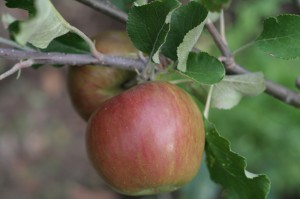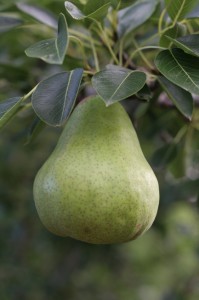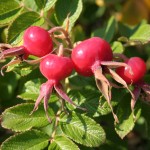This bountiful season of “mists and mellow fruitfulness” sees an abundance of ripe pome fruits on the trees. As well as the better known apples and pears there are also persimmons, pomegranates, quinces, rowans and rose hips.
Our supermarkets and greengrocers offer only about 5 varieties of apples and 3 different pears and we almost never see any of the other autumn fruits mentioned above. The obvious conclusion is that if you want really good fruit and anything other than these common varieties then you need to grow them yourself.
Although you can now buy potted fruit trees all year round, it’s best to use bare rooted apple and pear trees. These are purchased and planted in winter when you’ll find most nurseries offer at least a limited range. Autumn however, is the perfect time to plan your orchard (no matter how small), to taste the different varieties and to order your plants. At the National Trust Property, Rippon Lea, there is a large orchard of more than 100 different apples and 30 different pears. They have an Apple Day on Sunday 3rd of April 2011 when 40 of these varieties will be for sale, including some that are grown only for cider.
Apart from Rippon Lea, if you want something other than the more common varieties then you’ll need to order your trees from a specialist nursery.
For apples you can’t go past Heritage Fruit Trees. They stock more 80 apple varieties with names like Cornish Aromatic, Grand Duke Constantine, Winter Banana (all good eating apples) and Catshead, Golden Harvey and King of Tompkin’s County (what self-respecting gardener could be without one?), all cooking apples. When ordering, don’t forget that apples and pears need another variety of the same species with which to cross-pollinate. So unless you have neighbours with trees, you will have to plant two varieties with similar flowering times (ask your nurseryman for advice about compatible varieties).
While deciding what varieties you would like to grow you also need to take into account the space available. Both apples and pears are fairly tough trees and will tolerate a range of soils, although pears are more tolerant of poor drainage and heavy clay soils. They both like a sunny, open position, cool to cold weather during dormancy (winter) and adequate water during dry periods. Top dress with compost or well rotted animal manure twice a year and mulch to discourage too much weed or grass growth underneath. If you don’t have much room then purchase trees that are grafted onto dwarf rootstock. They grow to about 1.5 metres and produce a good crop in 3-4 years, or semi-dwarf which grow to about 2 metres and will produce a good crop in 4-5. Normal apple trees grow to about 6 metres with a spreading canopy while pears are even taller. Most varieties of both will take about 8 years to produce really good crops. Another possibility is to purchase a tree that has several different apples or pears grafted onto the one rootstock. This makes it possible to grow several different varieties with different uses and cropping times on one or two trees. With careful planning you may be able to harvest apples for up to six months.
Pruning apples and pears is a very important, and will affect the shape of the tree, the length of time they take to bear fruit and the ease of harvest. Most books advise pruning to a vase shape followed by regular pruning to keep the tree open and remove any crossed or dead branches. Allen Gilbert, the well known gardening author (see his book All About Apples for sale in our shop), advocates pruning to a mushroom shape that keeps the trees much smaller and encourages earlier harvests. Both methods are beyond the scope of this article but any good general gardening book will contain pruning instructions.
When trees begin to bear, remove small fruit so that there are only two fruit per cluster. Harvest apples when they are ripe, but pears need to be picked while still hard and ripened off the tree as they go soft and mushy if left to ripen on the tree.
Once trees are established they are tough and relatively easy to look after and only a few pests and diseases prove troublesome. One that affects apples, pears and quinces is the codlin moth. This can be hard to control. Always collect and destroy any dropped fruit, if you have chooks let them scavenge around the base of the trees, encourage native birds to feed on the moths and caterpillars and place corrugated cardboard or hessian collars around the trunk of the tree in summer and autumn to catch the migrating caterpillars. Destroy the collars and any larvae once the harvest has finished. Spray foliage with white oil in early spring to smother the eggs. Apple scab is a fungal disease that causes black spots and blistering on the leaves and branches and affects both apples and pears. Remove and burn any diseased leaves, twigs and fruit. Thin out extra branches to open out the canopy and allow more air movement, plant chives under the tree and spray with bordeaux mixture. Pear and cherry slug often seen on pear trees can be controlled by sprinkling the slugs with wood ash, talcum powder or chalk.
Of the other fruits that can be harvested in autumn, quinces can be planted and virtually forgotten as they are very tough individuals. They are excellent stewed or made into jams and jellies. Pomegranates produce large seed-filled fruit. These are delicious in fruit salad and produce a juice high in vitamin C. Trees grow to about 5 m and tolerate very dry conditions. Persimmons are harvested in late autumn when all the leaves have dropped and the fruit is bright red. Cultivars available today are not astringent and can be eaten straight from the tree. Rowans are hardy, very ornamental trees covered by bright red/orange berries in summer and autumn. Berries are not usually eaten fresh but can be used to make a delicious sour jelly that combines well with lamb and chicken dishes. Although roses are usually grown for their flowers, there are several varieties that also produce hips in autumn.
Rosa rugosa is one of the best, but there are many others including the dog rose (Rosa canina) often seen growing beside the road or in old cemeteries. Most can’t be eaten fresh because of sharp hairs on the seeds inside the hips. They can, however, be stewed, made into syrup, jam and wine or used to flavour sugar, vinegar and honey. — PW




6 Comments
Hi, Penny! Haven’t seen you since your last book launch – love the website. As you know, my field is publishing, not gardening, so I have a couple of questions.
I’ve just moved into a new house with two magnificent apple trees. But they’re not ripe and I need to know how to identify them.
They’re about six metres tall but all the fruit seems to be on the lower branches. I suspect they need the top chopped off and all the branches in the centre thinned. My mother said they need to be fed, too. With what?
I’ve put your website into my favourites and I look forward to a weekly dose of gardening for complete idiots.
Kerry.
Hi Kerry,
Glad you like the website. Please let me know if there is anything you would like me to write about. There are so many different varieties of apple (possibly as many as 7000 worldwide) that you really need an expert to help you identify yours. As you are in Victoria, it might be worth going along to the Rippon Lea Estate apple day on the 3rd of April. Not only do they have many old varieties growing in the orchard, but this year Justin Buckley, the head gardener at Rippon Lea, says they have propagated over 40 different varieties and will have around 800 trees for sale. They have also procured some genuine cider varieties and grafted these as well. I’m sure there would be someone there on the day who could have a go at identifying your apples.
Where: Rippon Lea Estate, 192 Hotham St Elsternwick, 3185
When: Sunday April 3rd from 10am
As far as feeding goes, I would cut any grass really close to the ground, water well and spread compost, well rotted manure and worm castings over the surface. Add some trace elements and some gypsum and cover with mulch right out just past the drip-line of the tree. Don’t put the mulch up next to the trunk as this can cause collar rot. My favourite mulch is lucerne hay, pea straw or sugarcane mulch, because they let the water percolate through and gradually rot down adding organic matter to the soil. — PW
Thanks for the info on apples. I’m quite excited about gardening now that I own my first home, so I’ll be sure to get to Rippon Lea.
But I’ve found what I think is an old pear tree stuffed in behind them. It’s in very bad shape. It’s about eight feet tall and all the leaves are sort of brown and desiccated, and they’re covered in slimy little brown grubs about a centimetre long with a bulbous end (bum?). Are they poisonous? And if the tree can be saved by severe cutting back, would it survive replanting? I don’t know how old it is but it’s obviously been crowded out.
Thanks again for the website. It’s easy to engage with it even if you’re not an experienced gardener, and I like the “tone”.
Kerry.
Hi Kerry, Your pear has pear and cherry slug. They are not poisonous. You just need to sprinkle something on them that will dry them out. Lime is perfect but even talcum powder will do. I would certainly do no harm to cut back the tree and now is a good time to prune pears. Thin out extra branches to open the whole tree out, Peter Cundall (my guru on pruning) says that the branches left should be about 150mm apart, then cut each remaining growth spur back by about one third. — PW
Dear Penny
I have a new farmlet, no house and no trees! Plans in the pipeline though to address both deficiencies!! I have been collecting and nurturing some fruit trees in pots, waiting for the best time to plant and it sounds like the time has come at last.
I wonder what layout approach you would suggest. For example to create several “mixed” fruit tree groves , or to set out in rows orchard style.
My pink lady which I bought bare-rooted last spring has a very tall trunk now and has only one side branch which also grew madly. It looks unbalanced. Could I prune both back now as a summer shaping or should I plant it out and let it establish first?
Your website is looks beautiful, I just heard you mention on 3CR that your son designed it. Great work and I’m looking forward to roaming around it regularly.
Cheers
Vicki
Hi Vicki,
Good luck with your plans for the orchard. What fun to be starting from scratch. Really the design depends on what you like. My inclination would be to have groves, interspersed with other plantings. But if you are a very neat person you might be better to put them in rows and it can make maintenance easier. Before you start it might be worth having a look at Allen Gilbert’s book All About Apples, as well as dealing with a huge number of varieties of apples, pruning and organic solutions for pests and diseases of apples, it also looks at some real life examples of organic and permaculture orchards, how they have been laid out, distance between trees and so on. You should be able to borrow it from your local library, but if not, I have copies for sale in the shop: All About Apples It would be fine to cut back the pink lady right now. Generally it is best to cut back new growth by one third in summer, but it would also be ok to even yours up so that it looks more balanced, even if this means taking off more than one third. — PW